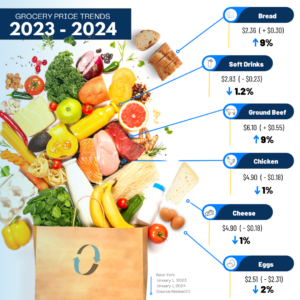
When it comes to the accessibility of some of our favorite supermarket items, it feels like pricing fluctuates almost daily. But what truly lies behind the numbers on those price tags? The factors that contribute to those ever changing prices go beyond what meets the eye.
Market Demand, Seasonality & Disruptions
According to the U.S. Department of Agriculture, all food prices are predicted to increase 1.3% in 2024. While this is a mild increase in comparison to the previous two years, this increase can be influenced greatly by the cost of raw materials. The basic principle of supply and demand plays a significant role in determining grocery prices. When demand for certain products outstrips supply, prices are likely to rise. Similarly, seasonal fluctuations in supply, such as crop harvests or weather-related disruptions, can impact prices for seasonal fruits, vegetables, and other perishable goods.Supply chain disruptions, whether due to natural disasters, geopolitical tensions, or global pandemics, can cause a domino effect that echoes throughout the entire supply chain. From delays in shipping and distribution to shortages in key ingredients or products, these disruptions can lead to increased costs for retailers, which are often passed on to consumers in the form of higher prices.
Fuel Costs
At the heart of the matter lies the fuel that powers the intricate web of transportation in our supply chains. Fluctuations in fuel prices can send ripples throughout the entire system, impacting the cost of transporting goods from farms and factories to supermarket shelves. The U.S. national average for gas prices is expected to drop from $3.51 per gallon in 2023 to $3.38 in 2024. This can help offset and minimize any other cost increases further down the supply chain and help keep prices closer to that 1.3% increase we anticipate in 2024.
Labor Costs and Regulatory Requirements
Behind every product on the shelf are countless hours of labor, from farm workers to factory employees to supermarket staff. As labor costs rise due to factors such as minimum wage increases or labor shortages, retailers may need to adjust prices to maintain profitability. Additionally, regulatory requirements, such as food safety standards and labeling regulations, can also influence production costs and retail prices.
In the complex ecosystem of supply chains and supermarkets, a wide variety of factors interact to determine the prices we see on grocery store shelves. From fuel costs and supply chain disruptions to market demand, labor costs, and regulatory requirements, each piece of the puzzle contributes to the final price consumers pay. By understanding these factors, we can gain insight into the dynamics shaping grocery prices and make informed choices as consumers in an ever-changing marketplace.

